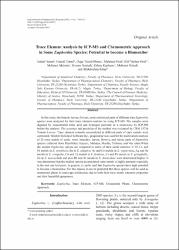Trace element analysis by icp-ms and chemometric approach in some euphorbia species: Potential to become a biomonitor

View/
Date
2019Author
Yener, İsmailTemel, Hamdi
Tokul-Ölmez, Özge
Fırat, Mehmet
Oral, Elif Varhan
Akdeniz, Mehmet
Ertaş, Abdülselam
Metadata
Show full item recordAbstract
In this study, the branch, leaves, flowers, roots and mixed parts of different nine Euphorbia species were analyzed for their trace element contents by using ICP-MS. The samples were digested by concentrated nitric acid and hydrogen peroxide in a microwave by ICP-MS before the analysis. The accuracy and precision of the method was evaluated by CRM 1573a Tomato Leaves. Trace element contents accumulated in different parts of each sample were contrasted. Minitab Statistical Software Inc., programme was used for the multivariate analysis of 12 toxic metals of seeds, roots, branches, leaves, flowers, and mixed parts of Euphorbia species collected from Diyarbakir, Kayseri, Malatya, Mardin, Trabzon, and Van cities.When the studied Euphorbia species are compared in terms of their metal contents; V, Tl, Cr, and Ni metals in E. eriophora, Ba in E. aleppica, As and Co metals in E. segıieriana, Ag and Se metals in E. craspedia, Cu and Cd metals in E. fistulosa, Cs and Pb metals in E. grisophylla, Zn in E. macroclada and also Rb and Sr metals in E. denticulata were determined higher. It was determined that the studied species accumulated some metals at highly amounts especially in the root and leaf parts. In general, it can be said that Euphorbia species have high potential to become a biomonitor. For this reason, it can be predicted that these species will be used as ornamental plants in landscape architecture due to both their toxic metals retention properties and their beautiful appearance. © 2019, Iranian Journal of Pharmaceutical Research. All rights reserved.

















